Page 113 of 392
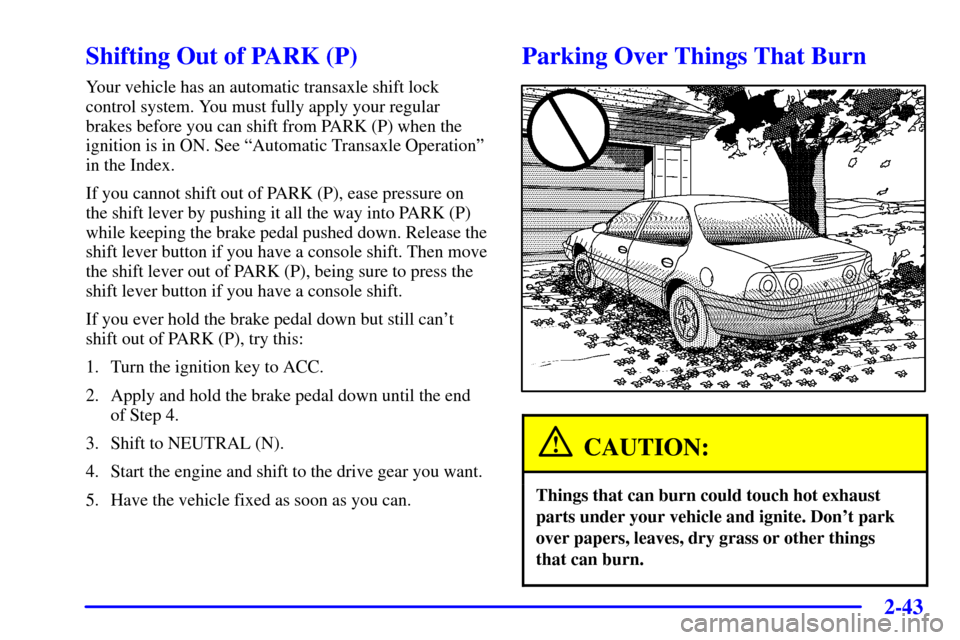
2-43
Shifting Out of PARK (P)
Your vehicle has an automatic transaxle shift lock
control system. You must fully apply your regular
brakes before you can shift from PARK (P) when the
ignition is in ON. See ªAutomatic Transaxle Operationº
in the Index.
If you cannot shift out of PARK (P), ease pressure on
the shift lever by pushing it all the way into PARK (P)
while keeping the brake pedal pushed down. Release the
shift lever button if you have a console shift. Then move
the shift lever out of PARK (P), being sure to press the
shift lever button if you have a console shift.
If you ever hold the brake pedal down but still can't
shift out of PARK (P), try this:
1. Turn the ignition key to ACC.
2. Apply and hold the brake pedal down until the end
of Step 4.
3. Shift to NEUTRAL (N).
4. Start the engine and shift to the drive gear you want.
5. Have the vehicle fixed as soon as you can.
Parking Over Things That Burn
CAUTION:
Things that can burn could touch hot exhaust
parts under your vehicle and ignite. Don't park
over papers, leaves, dry grass or other things
that can burn.
Page 117 of 392

2-47
Turn Signal On Chime
If you leave either one of your turn signals on and
drive more than 3/4 mile (1.2 km), a chime will sound
to alert you.
Headlamp High/Low-Beam Changer
To change your headlamps from low beams to high
beams, or high to low, pull the multifunction lever all
the way toward you. Then release it.
When the high beams are
on, this blue light on the
instrument panel cluster
also will be on.
This light works only when the ignition key is in the ON
position, and your fog lamps (if equipped) will not be
illuminated when your high beams are on.
Flash-to-Pass Feature
This feature lets you use your high-beam headlamps to
signal the driver in front of you that you want to pass.
It works even if your headlamps are off.
To use it, pull the turn signal lever toward you a little,
but not so far that you hear a click.
If the headlamps are off or the low beams are on, the
high
-beam headlamps will turn on. They'll stay on
as long as you hold the lever toward you and the
high
-beam indicator on the dash will come on.
Release the lever to turn the high
-beam headlamps off.
Windshield Wipers
When the ignition key is in the ACC or ON position,
you can control the windshield wipers by turning the
band marked WIPER. For a single wiping cycle, turn the
band to MIST. Hold it there until the wipers start, then
let go. The wipers will stop after one cycle. If you want
more cycles, hold the band on MIST longer.
For steady wiping at low speed, turn the band to LO.
For high
-speed wiping, turn the band further, to HI.
To stop the wipers, turn the band to OFF.
Page 118 of 392
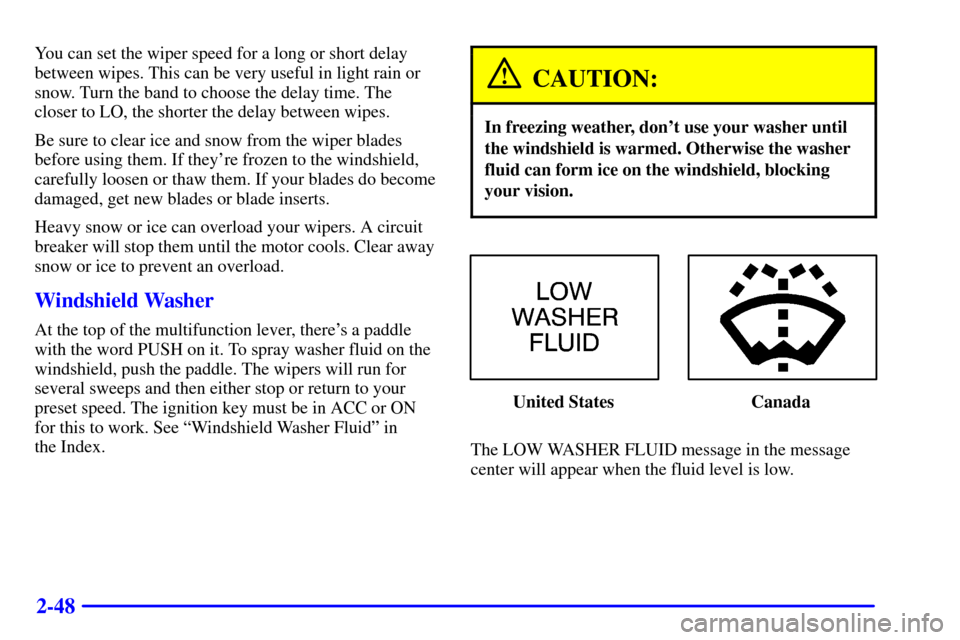
2-48
You can set the wiper speed for a long or short delay
between wipes. This can be very useful in light rain or
snow. Turn the band to choose the delay time. The
closer to LO, the shorter the delay between wipes.
Be sure to clear ice and snow from the wiper blades
before using them. If they're frozen to the windshield,
carefully loosen or thaw them. If your blades do become
damaged, get new blades or blade inserts.
Heavy snow or ice can overload your wipers. A circuit
breaker will stop them until the motor cools. Clear away
snow or ice to prevent an overload.
Windshield Washer
At the top of the multifunction lever, there's a paddle
with the word PUSH on it. To spray washer fluid on the
windshield, push the paddle. The wipers will run for
several sweeps and then either stop or return to your
preset speed. The ignition key must be in ACC or ON
for this to work. See ªWindshield Washer Fluidº in
the Index.
CAUTION:
In freezing weather, don't use your washer until
the windshield is warmed. Otherwise the washer
fluid can form ice on the windshield, blocking
your vision.
United States Canada
The LOW WASHER FLUID message in the message
center will appear when the fluid level is low.
Page 119 of 392
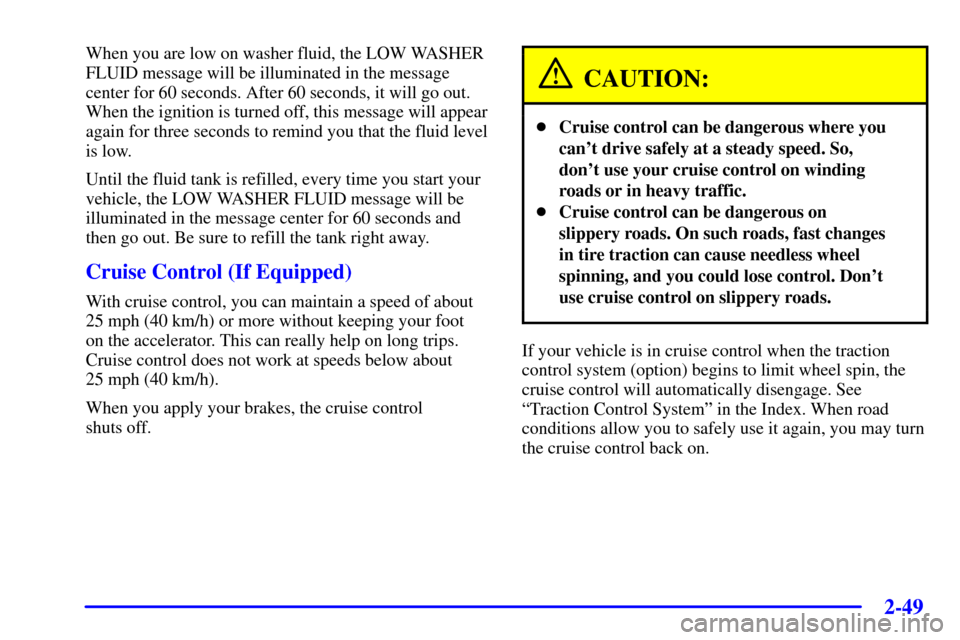
2-49
When you are low on washer fluid, the LOW WASHER
FLUID message will be illuminated in the message
center for 60 seconds. After 60 seconds, it will go out.
When the ignition is turned off, this message will appear
again for three seconds to remind you that the fluid level
is low.
Until the fluid tank is refilled, every time you start your
vehicle, the LOW WASHER FLUID message will be
illuminated in the message center for 60 seconds and
then go out. Be sure to refill the tank right away.
Cruise Control (If Equipped)
With cruise control, you can maintain a speed of about
25 mph (40 km/h) or more without keeping your foot
on the accelerator. This can really help on long trips.
Cruise control does not work at speeds below about
25 mph (40 km/h).
When you apply your brakes, the cruise control
shuts off.
CAUTION:
�Cruise control can be dangerous where you
can't drive safely at a steady speed. So,
don't use your cruise control on winding
roads or in heavy traffic.
�Cruise control can be dangerous on
slippery roads. On such roads, fast changes
in tire traction can cause needless wheel
spinning, and you could lose control. Don't
use cruise control on slippery roads.
If your vehicle is in cruise control when the traction
control system (option) begins to limit wheel spin, the
cruise control will automatically disengage. See
ªTraction Control Systemº in the Index. When road
conditions allow you to safely use it again, you may turn
the cruise control back on.
Page 122 of 392
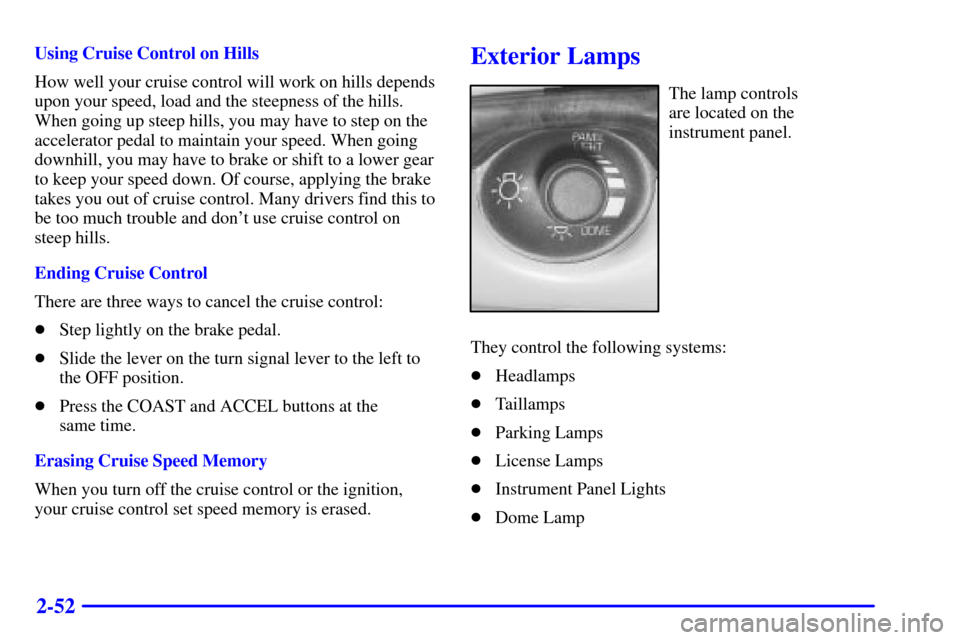
2-52
Using Cruise Control on Hills
How well your cruise control will work on hills depends
upon your speed, load and the steepness of the hills.
When going up steep hills, you may have to step on the
accelerator pedal to maintain your speed. When going
downhill, you may have to brake or shift to a lower gear
to keep your speed down. Of course, applying the brake
takes you out of cruise control. Many drivers find this to
be too much trouble and don't use cruise control on
steep hills.
Ending Cruise Control
There are three ways to cancel the cruise control:
�Step lightly on the brake pedal.
�Slide the lever on the turn signal lever to the left to
the OFF position.
�Press the COAST and ACCEL buttons at the
same time.
Erasing Cruise Speed Memory
When you turn off the cruise control or the ignition,
your cruise control set speed memory is erased.Exterior Lamps
The lamp controls
are located on the
instrument panel.
They control the following systems:
�Headlamps
�Taillamps
�Parking Lamps
�License Lamps
�Instrument Panel Lights
�Dome Lamp
Page 123 of 392

2-53
If you pull the knob out halfway, it will turn on your
parking lamps and your other operating lamps. If you
pull the knob all the way out, your headlamps will then
come on.
Push the knob in all the way to turn off the lamps.
A warning chime will sound if you open the driver's
door when you turn the ignition switch to OFF with
the lamps on.
Daytime Running Lamps / Automatic
Headlamp Control
Daytime Running Lamps (DRL) can make it easier for
others to see the front of your vehicle during the day.
DRL can be helpful in many different driving
conditions, but they can be especially helpful in the
short periods after dawn and before sunset. Fully
functional daytime running lights are required on all
vehicles first sold in Canada.
A light sensor on top of the instrument panel makes the
DRL work, so be sure it isn't covered.The DRL system will make your high
-beam headlamps
come on at a reduced brightness when the following
conditions are met:
�The ignition is on,
�the headlamp switch is off and
�the gearshift is not in PARK (P).
When the DRL are on, only your high
-beam
headlamps, at a reduced level of brightness, will be on.
The headlamps, taillamps, sidemarker and other lamps
won't be on. Your instrument panel and cluster won't be
lit up either.
When it's dark enough outside, your high
-beam
headlamps will turn off and the headlamps and parking
lamps will turn on. The other lamps that come on with
your headlamps will also come on.
When it's bright enough outside, your headlamps will go
off and your DRL will come on.
As with any vehicle, you should turn on the regular
headlamp system when you need it.
Page 124 of 392
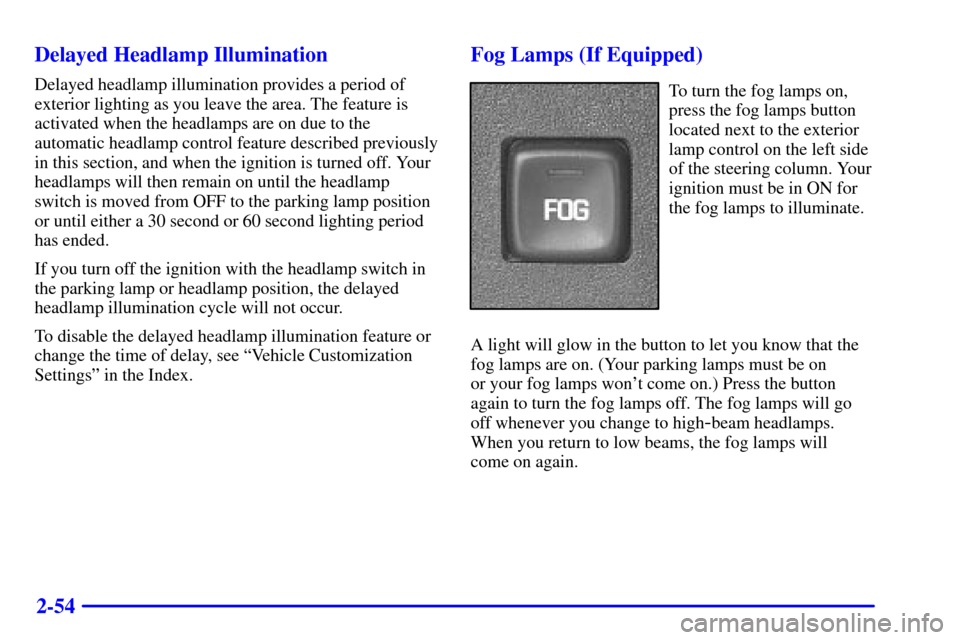
2-54 Delayed Headlamp Illumination
Delayed headlamp illumination provides a period of
exterior lighting as you leave the area. The feature is
activated when the headlamps are on due to the
automatic headlamp control feature described previously
in this section, and when the ignition is turned off. Your
headlamps will then remain on until the headlamp
switch is moved from OFF to the parking lamp position
or until either a 30 second or 60 second lighting period
has ended.
If you turn off the ignition with the headlamp switch in
the parking lamp or headlamp position, the delayed
headlamp illumination cycle will not occur.
To disable the delayed headlamp illumination feature or
change the time of delay, see ªVehicle Customization
Settingsº in the Index.
Fog Lamps (If Equipped)
To turn the fog lamps on,
press the fog lamps button
located next to the exterior
lamp control on the left side
of the steering column. Your
ignition must be in ON for
the fog lamps to illuminate.
A light will glow in the button to let you know that the
fog lamps are on. (Your parking lamps must be on
or your fog lamps won't come on.) Press the button
again to turn the fog lamps off. The fog lamps will go
off whenever you change to high
-beam headlamps.
When you return to low beams, the fog lamps will
come on again.
Page 125 of 392

2-55
Interior Lamps
Instrument Panel Brightness Control
You can brighten or dim the instrument panel and cluster
lights by turning the exterior lamp knob. Turn the knob
clockwise to increase the brightness of the instrument
panel and cluster, and counterclockwise to decrease the
brightness. Your parking lamps must be on for this
feature to work.
Courtesy Lamps
When any door is opened, several lamps come on.
These lamps are courtesy lamps. They make it easy for
you to enter and leave your vehicle. You can also turn
these lamps on by turning the exterior lamp knob all the
way clockwise.
Some of the lamps have switches so you can turn them
on, even when the doors are closed. These lamps are
reading lamps.
Illuminated Entry (If Equipped)
Your courtesy lamps will come on and stay on for a set
time whenever you press UNLOCK on the remote
keyless entry transmitter (if equipped).
If you open a door, the lamps will stay on while it's open
and then turn off automatically about 25 seconds after
you close it. If you press UNLOCK and don't open a
door, the lamps will turn off after about 40 seconds.
Illuminated entry includes a feature called theater
dimming. With theater dimming, the lamps don't just
turn off at the end of the delay time. Instead, they slowly
dim after the delay time until they go out. The delay
time is canceled if you turn the ignition key to ON or
press the power door lock switch. The lamps will dim
right away.
When the ignition is on, illuminated entry is inactive,
which means the courtesy lamps won't come on unless
a door is opened.